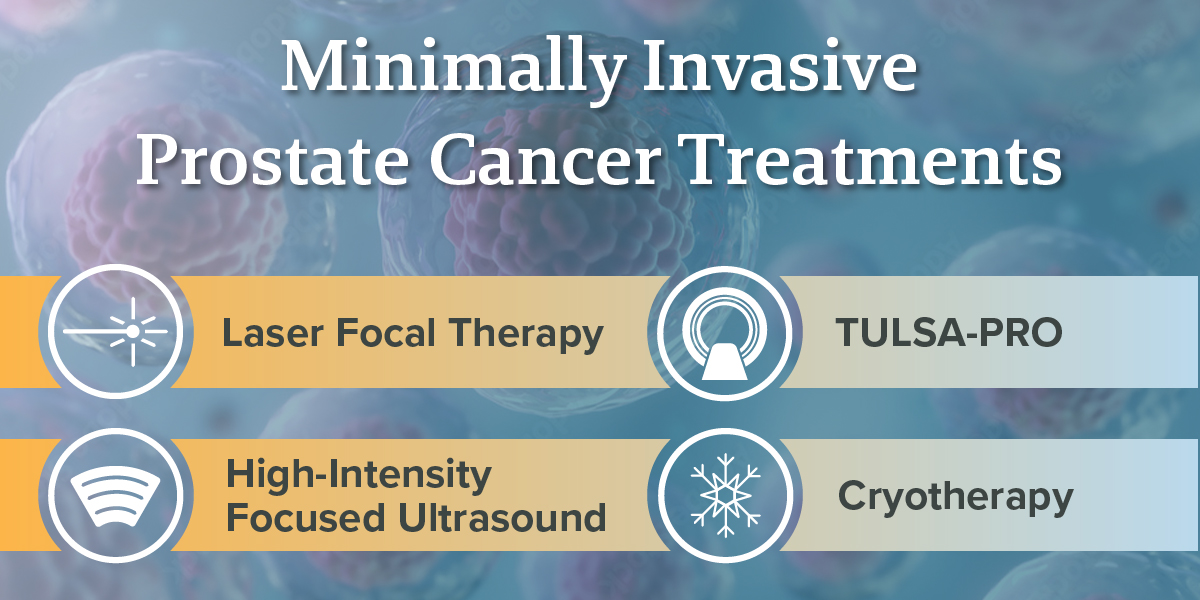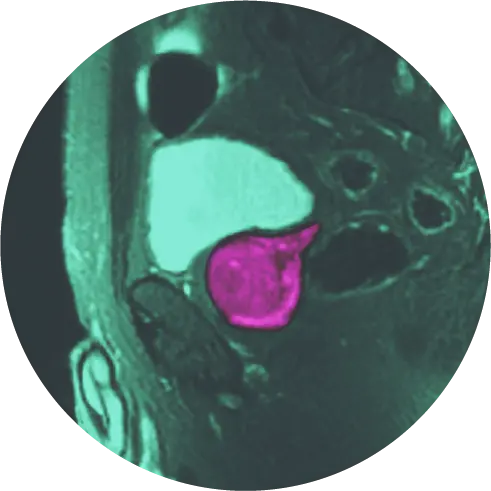As with any cancer treatment, selecting the best prostate cancer treatment from the available options depends on the type and spread of the disease.1 Because the disease can affect male sexual health, individual preference can influence the treatment decision. Additionally, we urge all men to assess the various post-procedure outcomes of all treatment options before making such an important decision regarding their prostate care.
Fortunately, about 80-85% of prostate cancers are found when the disease is localized to the prostate. For men whose prostate cancers are found early and confined to the prostate, the 5-year survival rate is nearly 100%. Physicians will help their patients discuss treatment options and choose the right path together.2
Prostate cancer patients should consider these factors when choosing a treatment:
- Short- and long-term side effects of treatment
- The potential for cancer to be cured
- The likelihood that the cancer will come back after treatment
- Chances of living longer with or without treatment
- Impact on quality of life and independence
- Personal preference is based on age, lifestyle, and comorbid medical conditions
Prostate Cancer Treatment Options
Treatment for prostate cancer can be minimal, invasive, or comprehensive, depending on the diagnosis and prognosis. Although some treatments, like radiation and chemotherapy, may be considered noninvasive, their systemic impact is significant. The choices for treatment can be confusing and overwhelming and may include:
- Surgery
- Radiation therapy
- Chemotherapy
- Hormone therapy
- Targeted therapy such as Focal Therapy
- Immunotherapy
- Active surveillance
- Palliative care
Surgical Options for Prostate Cancer Treatment
Medical treatments that are invasive usually entail a procedure that requires entering the body by puncturing or cutting the skin with an instrument.3 The most invasive treatment with a high likelihood of side effects, such as incontinence and sexual dysfunction, is surgery. The types of surgery for prostate cancer include:
- Radical prostatectomy – Surgical removal of the entire prostate. Lymph nodes in the pelvic area may also be removed.
- Robotic or laparoscopic prostatectomy – Less invasive than a radical prostatectomy. A camera and instruments are inserted through small incisions in the patient’s abdomen.
- Bilateral orchiectomy – Surgical removal of both testicles.4
Minimally Invasive Prostate Cancer Treatment Options
Minimally invasive treatment options are those that cause the least harm to the surrounding body structures. Examples of minimally invasive procedures include prostate laser surgery like laser focal therapy, TULSA-Pro, cryotherapy, and high-intensity focused ultrasound.

Laser Focal Therapy
Laser Focal Therapy (focal laser ablation) can be used to treat prostate cancer and can also help improve the symptoms associated with benign prostatic hyperplasia (BPH).
This procedure involves placing the patient inside an MRI machine and displaying images and thermal maps on a computer screen. A thin laser fiber is guided to the tumor, and laser energy is applied to ablate, or kill, cancer cells. There are no incisions or radiation.
The temperature and the extent of the ablation area are constantly monitored with MRI imaging, allowing clinicians to determine if all visible tumors have been destroyed. Surrounding structures are protected by cooling during the procedure.
Benefits of Laser Focal Therapy include:
- No general anesthesia required
- Improved urination after the procedure
- Lower risk of side effects such as urinary incontinence, impotence, and decreased bowel function
- Better accuracy compared with other focal approaches
- No limitations to using radiation or surgery later if indicated
TULSA-PRO® Prostate Treatment
The Transurethral Ultrasound Ablation (TULSA) procedure is a minimally invasive procedure that uses directional ultrasound to produce very high temperatures and ablate targeted prostate tissue. There are no incisions or radiation.
The procedure is performed in a Magnetic Resonance Imaging (MRI) suite and uses the TULSA-PRO® system to ablate prostate tissue from the “inside-out.” The procedure combines real-time MRI with robotically driven, directional thermal ultrasound to deliver predictable, physician-prescribed ablation of the whole gland or partial prostate tissue.
The device actively protects the urethra and rectum with cooling during treatment, maintaining a safe temperature to prevent damage to these critical structures.
Benefits of TULSA-PRO® include:
- Decreased risk of side effects such as erectile dysfunction and urinary problems
- Same-day outpatient procedure
- Advanced image guidance
- Customizable treatment based on patient preferences
- The option of a repeat procedure or other types of prostate therapy
Cryotherapy
Cryotherapy for prostate cancer freezes prostate tissue, causing the cancer cells to die. Thin metal probes are inserted through the skin and into the prostate. The probes are filled with a gas that causes the nearby prostate tissue to freeze.5
Cryotherapy might be used to treat early-stage prostate cancer that is confined to one part of the prostate when other treatments aren’t an option. Cryotherapy for prostate cancer can also be used when the cancer has recurred after initial treatment.
Benefits of cryotherapy include:
- Decreased risk of side effects such as erectile dysfunction and urinary problems
- Same-day outpatient procedure
- Customizable treatment based on your situation and goals
High-Intensity Focused Ultrasound (HIFU)
High-Intensity Focused Ultrasound is a minimally invasive procedure that uses ultrasound waves to treat prostate cancer by focusing on the exact tissue that requires treatment.6 This treatment does not involve radiation and does not require incisions. Smaller and less aggressive cancers are good candidates for treatment with HIFU.
According to Urology Times, “Among 100 patients with prostate cancer who received HIFU, 91% were able to avoid radical treatment for at least 2 years, according to the retrospective analysis, which was published in the Journal of Urology. Also, nearly three-fourths (73%) of patients did not experience treatment failure, and there was a 100% continence preservation rate.”7
Benefits of the HIFU treatment include:
- Limited side effects
- Low risk of incontinence and erectile dysfunction
- Outpatient surgery procedure with a short recovery time
Consulting with an Expert to Choose the Best Treatment
Patients should talk to their healthcare provider before making any decisions about their treatment plan. Advances in prostate cancer treatment continue to offer additional options, such as the minimally invasive procedures discussed here.
Contact HALO’s team of prostate experts today to discuss your specific situation and ask whether focal therapy, TULSA-PRO®, cryotherapy, or HIFU treatment options could be right for you.
References
- https://www.cancer.net/navigating-cancer-care/how-cancer-treated/making-decisions-about-cancer-treatment
- https://www.hopkinsmedicine.org/health/conditions-and-diseases/prostate-cancer/prostate-cancer-prognosis
- https://www.cancer.gov/publications/dictionaries/cancer-terms/def/invasive-procedure
- https://www.cancer.net/cancer-types/prostate-cancer/types-treatment
- https://www.mayoclinic.org/tests-procedures/cryotherapy-for-prostate-cancer/about/pac-20384740
- https://my.clevelandclinic.org/health/treatments/16541-hifu-high-intensity-focused-ultrasound
- https://www.urologytimes.com/view/hifu-allows-91-of-patients-to-avoid-radical-prostate-cancer-treatment-for-2-years




